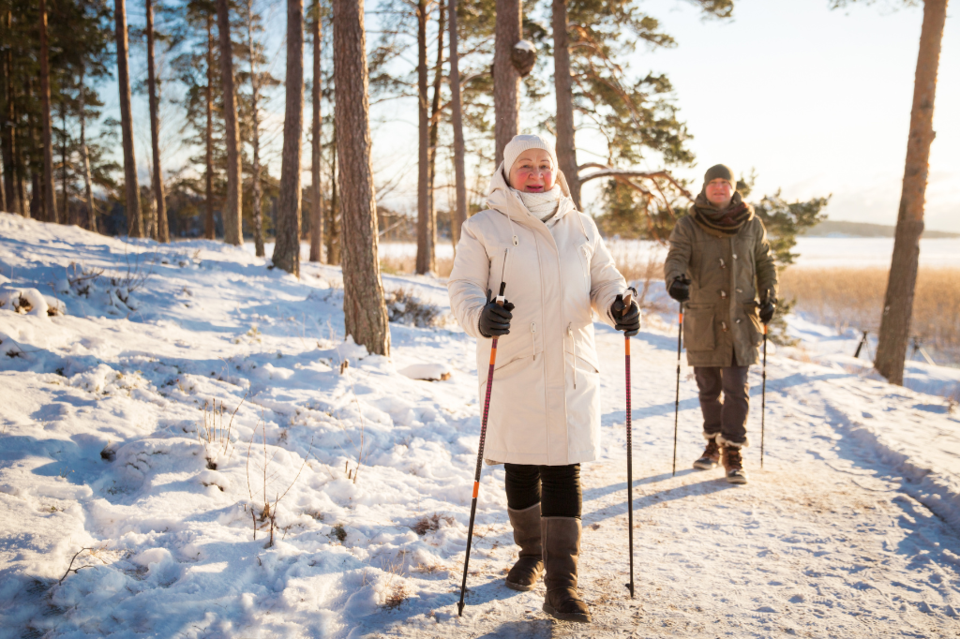Winter can be a challenging season for individuals living with arthritis. The cold, damp weather often intensifies joint pain and stiffness, while the increased risk of falls and the isolating nature of the season can take a toll on physical and emotional well-being.
However, with the right strategies, it’s possible to navigate winter comfortably and safely. Based on insights from the Arthritis Society of Canada, here are practical tips to help seniors with arthritis stay healthy, active, and prepared during the colder months.

1. Stay Active Indoors
Maintaining regular exercise is crucial for managing arthritis, as it helps reduce pain, improve joint function, and enhance overall well-being. Staying indoors doesn’t have to mean staying inactive:
-
Start with a 10-minute warm-up to prepare your body.
-
Opt for low-impact activities that strengthen muscles and increase heart rate, such as walking, using a stationary bike, or swimming.
-
Use weights or resistance bands for strength training.
-
Finish with a 10-minute cool-down to relax your muscles.
Before starting a new exercise routine, consult your healthcare provider for personalized advice. You can also visit the Arthritis Society’s Staying Active guide for more resources.
2. Ensure a Safe Home Environment
Arthritis can increase the risk of falls due to weakened muscles and poor balance. Make your home safer with these adjustments:
-
Remove tripping hazards like rugs, cords, and spills.
-
Improve lighting and wear visual aids like glasses when needed.
-
Use mobility aids such as canes or walkers as required.
-
Install grab bars in bathrooms and use non-slip mats.
-
Wear supportive footwear and avoid loose clothing.
-
Take medications as prescribed and organize them using blister packs or dosettes to stay on track.
-
For tasks like shovelling snow, don’t hesitate to ask for help.
3. Stock Up on Essentials
Winter storms and icy conditions can make it difficult to leave home. Be prepared with:
-
A stockpile of non-perishable food and medications for 5-7 days.
-
Flashlights, batteries, and a charged phone for emergencies.
-
Plans for grocery or pharmacy delivery services, or help from a neighbour or family member.

4. Stay Safe Outdoors
Winter weather can pose unique challenges for those with arthritis. To minimize risks:
-
Be aware of frostbite, hypothermia, and other cold-related conditions. Seek medical attention if you notice symptoms like blackened skin or extreme fatigue.
-
Dress warmly in layers and wear waterproof boots with good insulation and non-skid soles.
-
Consider attaching ice grips to mobility aids for extra traction.
5. Use Proper Shovelling Techniques
If you must shovel snow, protect yourself by:
-
Stretching beforehand to prevent injury.
-
Pushing snow instead of lifting when possible.
-
Lifting with your knees and avoiding heavy loads.
-
Taking frequent breaks and not overexerting yourself.
Alternatively, hire someone to handle snow removal for you.
6. Dress in Layers
Layering is key to staying warm and preventing hypothermia. Wear loose-fitting clothing, warm socks, gloves, a hat, and a scarf to cover exposed skin. Indoors, keep a blanket handy and maintain a comfortable home temperature.

7. Be Mindful of Winter Blues
Long, cold months can lead to feelings of isolation and sadness, known as seasonal affective disorder (SAD). To combat this:
-
Stay connected with family and friends through calls or visits.
-
Seek professional help if you notice persistent mood changes or fatigue.
8. Always Be Prepared
In case of emergencies:
-
Keep emergency contact numbers easily accessible.
-
Use a medical alert system if needed.
-
Arrange for a friend, neighbour, or family member to check on you regularly.
Winter doesn’t have to be daunting for seniors with arthritis. By staying active, making your environment safer, and preparing for the unexpected, you can enjoy the season with confidence and comfort.




